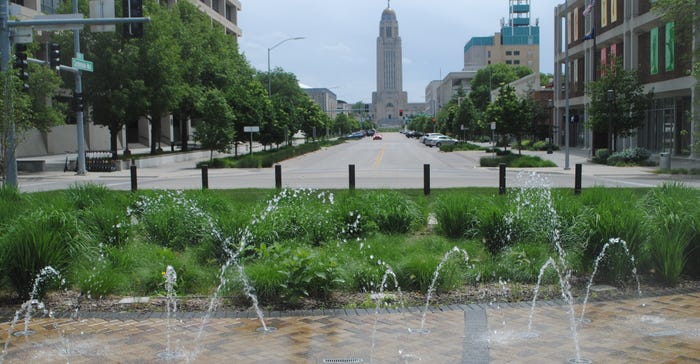
Most Nebraskans are familiar with our unique state Capitol building in Lincoln, which was designed by New York architect Bertram Goodhue and built in four phases over 10 years. It was completed in 1932.
What few residents probably know is that in 1922, just as Capitol construction was beginning, Goodhue also proposed a seven-block, wide avenue to create a beautiful north entrance to the new Capitol building.
By 1937, Lincoln city leaders, along with state officials, designated 120 feet of right of way reaching from the Capitol steps north to the University of Nebraska city campus.
Although a commission was assigned development of this new mall area, nothing happened until the state’s centennial celebration in 1967. Centennial Mall was born, with a series of fountains stretching to the Capitol on the south end and the Nebraska State Historical Society headquarters on the north end.
Revitalization
In 2009, the city of Lincoln made $3 million available for improvements to Centennial Mall. The revitalization project was completed just in time for Nebraska’s 150th celebration in 2017.
The project took on a themed approach, with a different focus between specific streets along the path. From K to L streets, the theme is called “We the People,” with artistic elements celebrating the democratic process that began with statehood and continues today.
The Capitol Fountain and the Great Seal of the State of Nebraska are noticeable features, with citizens and state leaders of the past recognized.
“Our Home Nebraska” stretches from L to M streets, focusing on the natural resources of Nebraska and the importance of stewardship. The cool feature of this block is a large plaza with a blockwide outline of the state with rivers and eco-regions represented in pavement.
The next section from M to P streets is called “Mosaic of Nebraskans,” including three central blocks that are the only ones in the mall open to vehicle traffic — with the focus on the people, cultures and organizations that come together to make Nebraska.
From P to R streets is called “Sparking the Good Life,” highlighting “Imagination to Innovation.” The two blocks in this section adjacent to campus feature the efforts of educators, artists and innovators. It includes a plaza area between the Lincoln Children’s Museum and UNL Anderson Hall where the College of Journalism and Mass Communications is located.
Honoring Standing Bear
In the campus zone, a 10-foot-tall statue of Chief Standing Bear of the Ponca Tribe was completed in 2017. The bronze statue, designed by Ben Victor, is similar in nature to the standing statue of Abraham Lincoln in front of the Capitol building.
It honors the famous Chief who was born in 1829 on the banks of the Niobrara River. In 1877, Standing Bear and the Ponca Tribe were forced by a federal treaty to leave their homeland on the Niobrara for Indian territory in Oklahoma.
Many members of the tribe suffered greatly along the terrible journey, including Standing Bear’s own son, who died following their arrival in Oklahoma. Wishing to bury his son in his native homeland in Nebraska, Standing Bear and a small band headed back to Nebraska. Arrested after their arrival back home, Standing Bear stood trial in Omaha.
As a result of the trial, he was the first Native American declared “a person” under the law, entitled to rights and protections that go along with this designation. Standing Bear’s immortal words from this famous trial are engraved near his statue on the mall.
Learn more about Centennial Mall in Lincoln at lincoln.ne.gov.
About the Author(s)
You May Also Like






